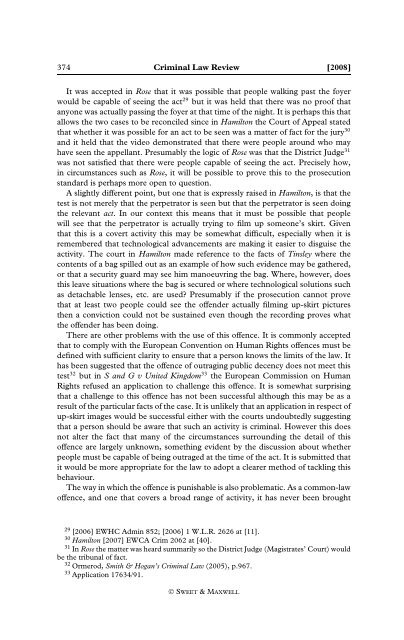ISSUE 5 2008 - Sweet & Maxwell
ISSUE 5 2008 - Sweet & Maxwell
ISSUE 5 2008 - Sweet & Maxwell
You also want an ePaper? Increase the reach of your titles
YUMPU automatically turns print PDFs into web optimized ePapers that Google loves.
374 Criminal Law Review [<strong>2008</strong>]<br />
It was accepted in Rose that it was possible that people walking past the foyer<br />
would be capable of seeing the act 29 but it was held that there was no proof that<br />
anyone was actually passing the foyer at that time of the night. It is perhaps this that<br />
allows the two cases to be reconciled since in Hamilton the Court of Appeal stated<br />
that whether it was possible for an act to be seen was a matter of fact for the jury 30<br />
and it held that the video demonstrated that there were people around who may<br />
have seen the appellant. Presumably the logic of Rose was that the District Judge 31<br />
was not satisfied that there were people capable of seeing the act. Precisely how,<br />
in circumstances such as Rose, it will be possible to prove this to the prosecution<br />
standard is perhaps more open to question.<br />
A slightly different point, but one that is expressly raised in Hamilton, is that the<br />
test is not merely that the perpetrator is seen but that the perpetrator is seen doing<br />
the relevant act. In our context this means that it must be possible that people<br />
will see that the perpetrator is actually trying to film up someone’s skirt. Given<br />
that this is a covert activity this may be somewhat difficult, especially when it is<br />
remembered that technological advancements are making it easier to disguise the<br />
activity. The court in Hamilton made reference to the facts of Tinsley where the<br />
contents of a bag spilled out as an example of how such evidence may be gathered,<br />
or that a security guard may see him manoeuvring the bag. Where, however, does<br />
this leave situations where the bag is secured or where technological solutions such<br />
as detachable lenses, etc. are used Presumably if the prosecution cannot prove<br />
that at least two people could see the offender actually filming up-skirt pictures<br />
then a conviction could not be sustained even though the recording proves what<br />
the offender has been doing.<br />
There are other problems with the use of this offence. It is commonly accepted<br />
that to comply with the European Convention on Human Rights offences must be<br />
defined with sufficient clarity to ensure that a person knows the limits of the law. It<br />
has been suggested that the offence of outraging public decency does not meet this<br />
test 32 but in S and G v United Kingdom 33 the European Commission on Human<br />
Rights refused an application to challenge this offence. It is somewhat surprising<br />
that a challenge to this offence has not been successful although this may be as a<br />
result of the particular facts of the case. It is unlikely that an application in respect of<br />
up-skirt images would be successful either with the courts undoubtedly suggesting<br />
that a person should be aware that such an activity is criminal. However this does<br />
not alter the fact that many of the circumstances surrounding the detail of this<br />
offence are largely unknown, something evident by the discussion about whether<br />
people must be capable of being outraged at the time of the act. It is submitted that<br />
it would be more appropriate for the law to adopt a clearer method of tackling this<br />
behaviour.<br />
The way in which the offence is punishable is also problematic. As a common-law<br />
offence, and one that covers a broad range of activity, it has never been brought<br />
29 [2006] EWHC Admin 852; [2006] 1 W.L.R. 2626 at [11].<br />
30 Hamilton [2007] EWCA Crim 2062 at [40].<br />
31 In Rose the matter was heard summarily so the District Judge (Magistrates’ Court) would<br />
be the tribunal of fact.<br />
32 Ormerod, Smith & Hogan’s Criminal Law (2005), p.967.<br />
33 Application 17634/91.<br />
© SWEET &MAXWELL






